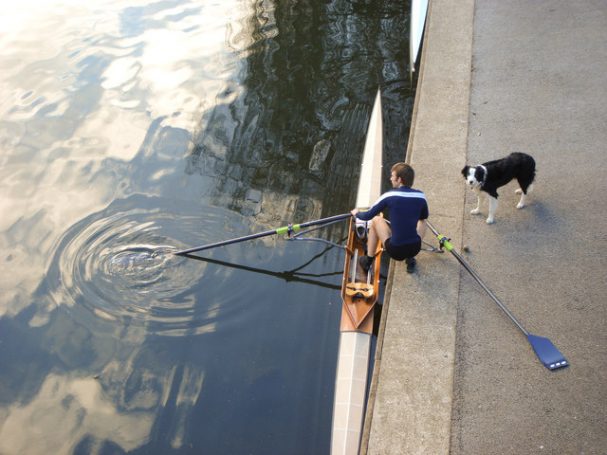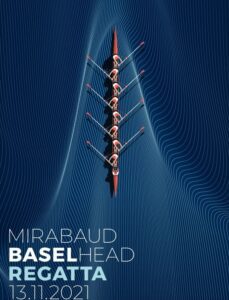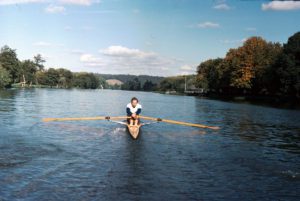Body-Boat Alignment Considerations for the Advanced Oarsman and the Aspiring Coach.
A guest blog by Dan Boyne
When the famous boat builder George Pocock was once asked why his rowing shells weren’t very adjustable, he reputedly answered: “Because an athlete is infinitely more adjustable than a boat.”
Whether or not this quote is true hardly matters, for it has been repeated enough times to make it both noteworthy and relevant even in this modern age of carbon fiber boats and fancy rigging configurations. Why? Because it speaks to the timeless dilemma faced by many an oarsman and their coach—trying to figure out the best way to accommodate a human being in a rowing shell, given the variability that each individual offers in terms of their intelligence and physical capabilities.
Incidentally, the Eton waterman’s clever quip eventually became reconstituted into the aphorism at the front of this essay—attributed to one of Pocock’s descendents, American boat builder Calvin Coffey. In what follows, I’ll try to examine and debate the merits of rigging to accommodate the modern oarsman versus the old school philosophy embodied by these two quotes—letting the athlete adjust to the rig.
An Organic Approach
First off, it may be important to point out that what Pocock and Coffey were saying here should not be misconstrued as a complete
laissez-faire
attitude, or an excuse not to look over your rigging if you are an athlete and to avoid the business of coaching if you are a coach. Even if you believe that Pocock was right, he believed in the value of teaching rowing technique to an oarsman as much as he believe in making good boats—both have to be shaped with an attention to detail.
The real question, then, is how much attention do we pay to each?
More specifically, when is it best to make a change to the rowing equipment and when is it best to make a change to the athlete? Some people spend countless hours fooling around with their rigging, while others seem more focused on perfecting rowing technique. Naturally, these two forms of obsessive behavior are not mutually exclusive, and it is possible to exhibit both forms of neurosis simultaneously. Usually, there is only one cure for this condition, which is to either give up rowing entirely or to give in and become that most dreaded beast—the single sculler!
All joking aside, the most important realization that I’ve made over my three decades of coaching (yes, mostly scullers) is that these two areas of attention—the boat and the athlete—can never be considered as independent from one another.
Instead, the equipment and the athlete must be viewed as one organic, interrelated system
With this rule in mind, if you make a change to one it will naturally produce an effect to the other.
Simple, right? But now, here comes the more difficult part, which is knowing when and how to skillfully make a change. In order to do this, let me step back for a second and offer up some basic “body-boat” principles by which you can access your relationship with your equipment.
Basic Body-Body Alignment Principles
- Determine the overall fit of the equipment to the athlete. This includes the hull size of the boat and the length of the oars, as well as the “finer” rigging measurements, which include oarlock height, seat-to-heel height, inboard, oar length, oarlock spread, etc. Any good rigging book or coach should be able to help you with these if you are a beginner.
- Create a stable, “comfortable” platform from which technique can be taught, based on athlete’s abilities and water conditions.
- Acknowledge that an upgrade in equipment doesn’t guarantee an upgrade in performance.
- An intelligent choice produces more synchronicity, ease, and sensory awareness between the two, rather than creating more antipathy/anxiety.
In a way, these rules really aren’t much different than the ones you might use to buy a suit, a dress, or any article of clothing—if you are being sensible, that is. Everything should fit in such a way that is not only sized appropriately to your body, but allows you to move about without feeling overly inhibited or self-conscious. Of course, people don’t allow shop sensibility when it comes to clothing, but they should when they are buying a boat. For while fancy, expensive clothing may indeed make you look better, a higher priced boat might not actually make you go faster!
The Rower in Motion
So now, with some basic equipment and rigging guideless in place, let’s look more closely how the rower and the boat move in concert—or not. This next section is mostly for coaches who want to know how to “train” their eye in order to make better choices about rigging and technique, but even if you are an athlete you may find some of this section useful. Again, the primary question here is simply this:
how well is the organic, inter-related system of the athlete and the equipment working
Here are some suggestions:
- Watch the movement of the boat, the oars, and the athlete the run of the boat; the smooth entry, exit, and drive of the oars; the quality of the athlete’s connection to the equipment—the hands, feet and seat).
- Scan what is working well, and what isn’t where is there integrity or disintegration?)
- Hone in on the key element that may be causing a disruption to the efficient movement of the boat through the stroke cycle. Use this as your entry point into an intelligent “stroke diagnosis,” rather than trying to make multiple, random corrections.
- Assess flexibility and strength issues and determine how they may be affecting this problematic part of the stroke.


Taking It One Step Further: Prioritizing Body-Boat Alignment Skills
What if you aren’t a coach, or don’t have access to one, and you still want to develop better body-boat alignment skills? In this case, the discussion above may seem very interesting to you, but it remains somewhat impractical and theoretical. Even if someone takes a video of your rowing, you don’t have the observational skills to know exactly where to begin your efforts toward self-improvement. Or maybe you are a relatively young coach who needs a sequential “template” to help prioritize the way in which you access a rower’s skills, without simply putting them on an erg and getting a 2k score!
If this is the case, here is a general plan for examining body-boat alignment skills more closely:
- Begin by looking at how the athlete balances the boat, beginning from the release and moving forward to the catch.
- Observe and cultivate the coordination of their body as it approaches the catch how well their legs, back, and arms move in unison).
- Observe and cultivate how aware they are of slide control and of creating “check.”
- Observe and cultivate their connection through all points of the drive.
- Cultivate sensitivity to three points of body-boat contact—seat, feet, and oar/oarlock.
Naturally, all of the above is merely a skeleton guide to some areas that coaches can spend hours parsing out and debating among themselves and their athletes. But it operates from this one very important premise:
without balance, everything else will suffer
This could be a slogan in and out of the boat, so take it to heart when you are accessing both yourself and the equipment that you choose.
The corollary to this rule may be equally enlightening, and it is something I’ve observed after watching thousands of oarsmen (and particularly scullers) purchase boats for themselves—
most people select equipment that is slightly above their level of competency
Why? The reason goes back to my earlier metaphor about clothing and boats, and where it fails.
Does this mean you should buy lesser quality equipment? Of course not! But don’t suffer from the delusion that a narrow, ultra light racing shell is going to turn you into a champion any more than you believe that a fanciful rigging change is going to make you go that much faster. Remember George Pocock’s refrain—“The athlete is infinitely more adjustable than the equipment”—and then figure out ways to improve yourself!
A General Plan for Teaching/Learning Body-Boat Alignment
This last section is written more for the coaches out there who are reading this essay and saying to themselves: “Yes, I agree with most of this, at least in theory, but practically speaking it’s not always easy to get athletes to adjust their stroke!” Agreed. So now we finally arrive at one of the biggest problems that can inhibit success: a student who does not possess much body-boat awareness, or worse—one who has been poorly trained by another coach.
And herein lies the one area where we could debate the efficacy of George Pocock’s sage advice, for while an athlete may indeed be “infinitely more adjustable than a boat,” getting them to adjust may take an infinite amount of skill and patience! Admittedly, some people are simply less coordinated than others, while others have a difficult time just feeling comfortable in the weird contraption known as a rowing shell. Older students, in particular, seem to exhibit some degree of fear around water and the possibility of capsizing, not to mention some other way of humiliating themselves.
If this is the case, then my overall suggestion is to take a two-fold approach—one that offers both more support when needed (via rigging changes, props, drills, and other devices),teach complementary skills on dry land balance, core strength, and overall muscle awareness). It would take an entirely separate article to delineate some of my favorite drills and dry land exercises, so I’ll just allude to a few of them here, while outlining a general plan. The overall emphasis, however, lies in developing fine motor skills in and out of the boat:
- Teach exercises which develop the athlete’s sensitivity and connection to the seat, oars/oarlocks, and footboard—if necessary by “shaking up” or “changing” their current mental paradigm in order to break bad habits
- Work from proximal to distal, from the core to the extremities. The overall notion here is that while we tend to coach from the extremities “arms do this, legs do that), an athlete’s physical integrity actually comes from the core outward to the limbs.
- Emphasize “smart” core strength and the athlete’s dynamic relationship to the boat’s balance via the rectus abdominals and obliques, and psoas, then deploy these skills in the boat with “balance” drills.
- Develop awareness in the hands, feet, shoulders, etc., in tandem with core awareness exercises.
- Deal with lack of strength and flexibility issues out of the boat as much as possible, before you consider a rigging change.
- Remember that bad strokes re-enforce one another.


Putting It All Together
So now let me unpack these rules a bit with a specific example that tries to complement some of what I’ve said up to this point.
Remember, one of the first observational rules for a coach is always to try and see how well the athlete interacts with their equipment—how do they grip the oars, how well do they adjust boat balance, how well do they move up the slide, etc. Since many coaches are obsessed with hands, this isn’t a bad example to chose—let’s call it “The Case of the Overgripper.”
If you observe a sculler with an overly tight grip, it is easy to immediately become fixated on their hands, and try to correct every little nuance of what is wrong with them—feathering with the wrist, adjusting the diameter of the oar handle, etc. While attending to these details themselves isn’t necessarily a bad thing, it may not be identifying the root of the problem—which is why the sculler’s grip is tight in the first place!
So what if we take the opposite strategy (proximal to distal) and tell the sculler to slide their hands down the loom of the oar—what will happen next? Well, first they will probably look at you rather strangely, and then (9 times out of 10) they will learn how to row with a wide grip and love it.
Now you’ve actually “de-emphasised” their hands and made them focus instead on using their core for balance, all with a very simple drill. Of course, if your student doesn’t have any core awareness, you may have to pull them back onto dry land and sit them down on the floor to learn some complementary core awareness exercises (like folding forward with bent knees and holding onto their own feet, then rocking from one sitting bone to the next). Or, lay them on their back and have them do some side-to-side crunches, etc., to develop some strength in that area.
Now your task is to transfer this dry land core training to the water, by getting them back in the boat and letting them feel how they connect to the hull of the boat via their seat—and more specifically; how subtle weight shifts on the sitting bones can affect the balance of the boat. Here you might have them work from the release to the finish, pausing and balancing at different points coming forward, and even learning to “tilt” the boat to port or to starboard by using the oblique muscles—with or without the wide grip hand position—teaching balance by creating imbalance.
Finally, when they have mastered a better sense of balance, you can go back and work on those hands again, without having them start to tighten up whenever the set of the boat goes off!








